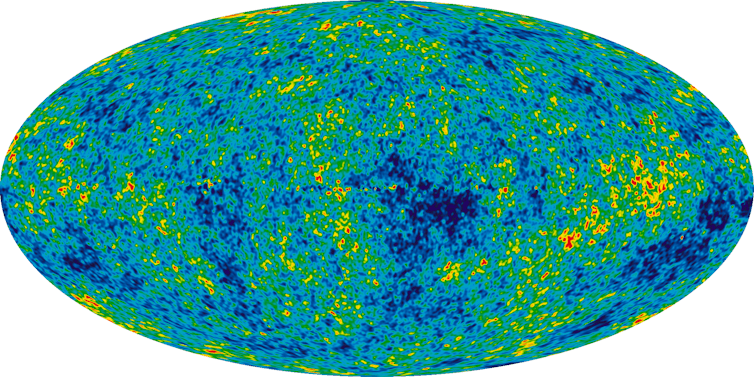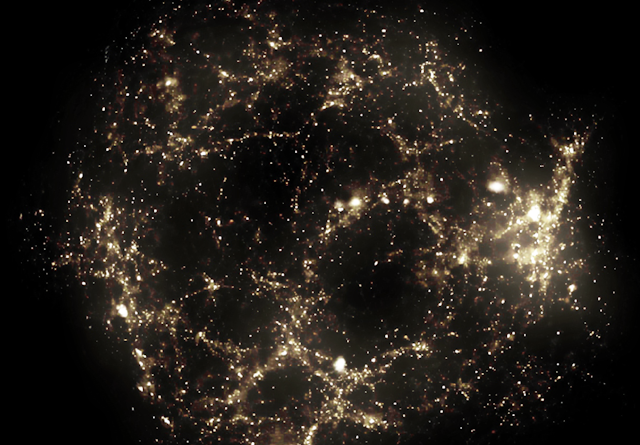One of the biggest mysteries in cosmology is the rate at which the universe is expanding. This can be predicted using the standard model of cosmology, also known as Lambda-cold dark matter (ΛCDM). This model is based on detailed observations of the light left over from the Big Bang – the so-called cosmic microwave background (CMB).
The universe’s expansion makes galaxies move away from each other. The further away they are from us, the more quickly they move. The relationship between a galaxy’s speed and distance is governed by “Hubble’s constant”, which is about 43 miles (70 km) per second per Megaparsec (a unit of length in astronomy). This means that a galaxy gains about 50,000 miles per hour for every million light years it is away from us.
But unfortunately for the standard model, this value has recently been disputed, leading to what scientists call the “Hubble tension”. When we measure the expansion rate using nearby galaxies and supernovas (exploding stars), it is 10% larger than when we predict it based on the CMB.
In our new paper, we present one possible explanation: that we live in a giant void in space (an area with below average density). We show that this could inflate local measurements through outflows of matter from the void. Outflows would arise when denser regions surrounding a void pull it apart – they’d exert a bigger gravitational pull than the lower density matter inside the void.
In this scenario, we would need to be near the centre of a void about a billion light years in radius and with density about 20% below the average for the universe as a whole – so not completely empty.
Such a large and deep void is unexpected in the standard model – and therefore controversial. The CMB gives a snapshot of structure in the infant universe, suggesting that matter today should be rather uniformly spread out. However, directly counting the number of galaxies in different regions does indeed suggest we are in a local void.
Tweaking the laws of gravity
We wanted to test this idea further by matching many different cosmological observations by assuming that we live in a large void that grew from a small density fluctuation at early times.
To do this, our model didn’t incorporate ΛCDM but an alternative theory called Modified Newtonian Dynamics (MOND).
MOND was originally proposed to explain anomalies in the rotation speeds of galaxies, which is what led to the suggestion of an invisible substance called “dark matter”. MOND instead suggests that the anomalies can be explained by Newton’s law of gravity breaking down when the gravitational pull is very weak – as is the case in the outer regions of galaxies.
The overall cosmic expansion history in MOND would be similar to the standard model, but structure (such as galaxy clusters) would grow faster in MOND. Our model captures what the local universe might look like in a MOND universe. And we found it would allow local measurements of the expansion rate today to fluctuate depending on our location.
Recent galaxy observations have allowed a crucial new test of our model based on the velocity it predicts at different locations. This can be done by measuring something called the bulk flow, which is the average velocity of matter in a given sphere, dense or not. This varies with the radius of the sphere, with recent observations showing it continues out to a billion light years.
Interestingly, the bulk flow of galaxies on this scale has quadruple the speed expected in the standard model. It also seems to increase with the size of the region considered – opposite to what the standard model predicts. The likelihood of this being consistent with the standard model is below one in a million.

This prompted us to see what our study predicted for the bulk flow. We found it yields a quite good match to the observations. That requires that we are fairly close to the void centre, and the void being most empty at its centre.
Case closed?
Our results come at a time when popular solutions to the Hubble tension are in trouble. Some believe we just need more precise measurements. Others think it can be solved by assuming the high expansion rate we measure locally is actually the correct one. But that requires a slight tweak to the expansion history in the early universe so the CMB still looks right.
Unfortunately, an influential review highlights seven problems with this approach. If the universe expanded 10% faster over the vast majority of cosmic history, it would also be about 10% younger – contradicting the ages of the oldest stars.
The existence of a deep and extended local void in the galaxy number counts and the fast observed bulk flows strongly suggest that structure grows faster than expected in ΛCDM on scales of tens to hundreds of millions of light years.
Interestingly, we know that the massive galaxy cluster El Gordo formed too early in cosmic history and has too high a mass and collision speed to be compatible with the standard model. This is yet more evidence that structure forms too slowly in this model.
Since gravity is the dominant force on such large scales, we most likely need to extend Einstein’s theory of gravity, General Relativity – but only on scales larger than a million light years.
However, we have no good way to measure how gravity behaves on much larger scales – there are no gravitationally bound objects that huge. We can assume General Relativity remains valid and compare with observations, but it is precisely this approach which leads to the very severe tensions currently faced by our best model of cosmology.
Einstein is thought to have said that we cannot solve problems with the same thinking that led to the problems in the first place. Even if the required changes are not drastic, we could well be witnessing the first reliable evidence for more than a century that we need to change our theory of gravity.

